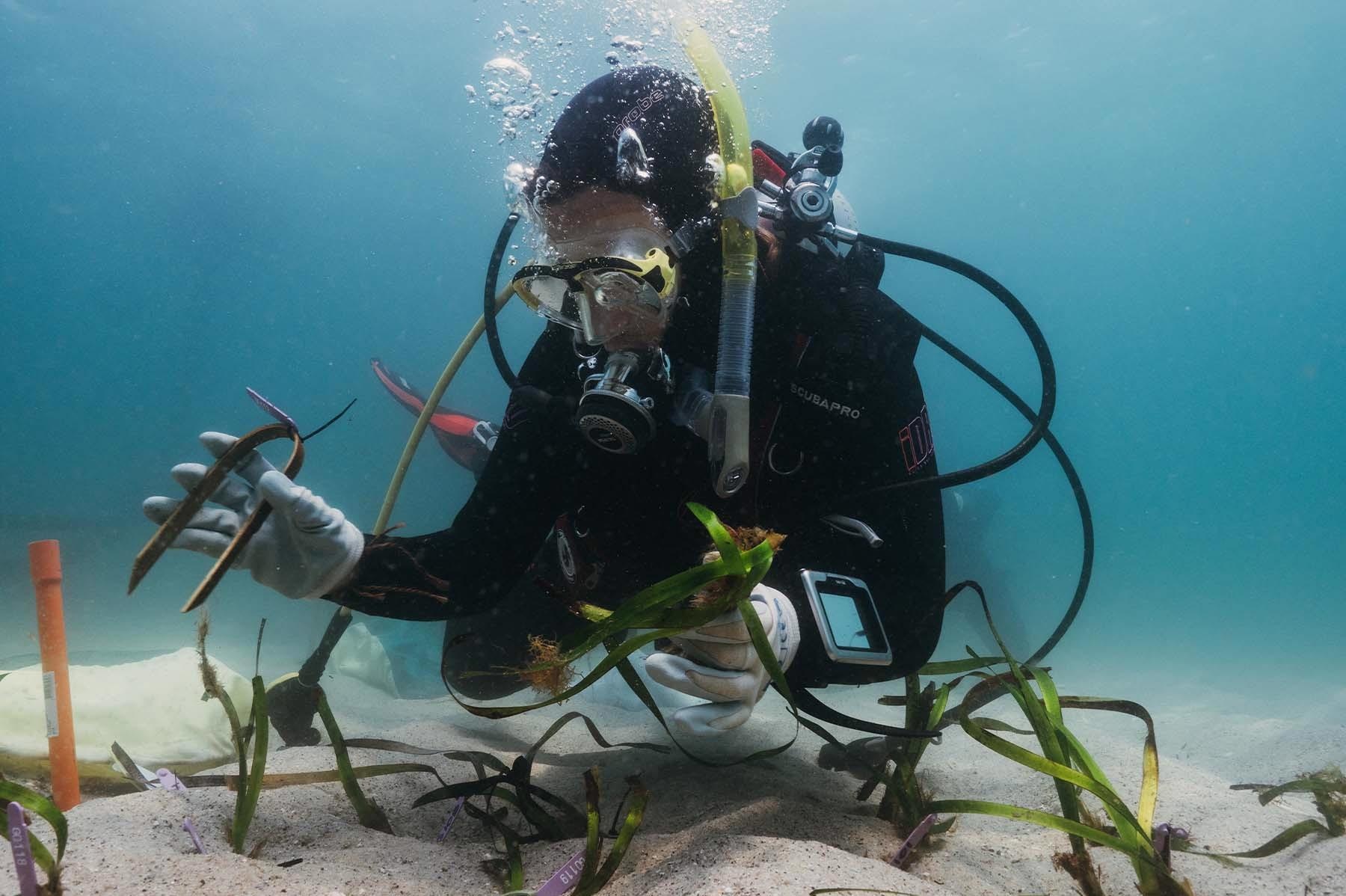An endangered seagrass which supports seahorses, blue swimmer crabs and fish like snapper is being successfully rehabilitated thanks to the help of citizen scientists and UNSW scientists.
 UNSW Science's Giulia Ferretto planting Posidonia australis into old boat mooring scars in Port Stephens. Image Credit: Grumpy Turtle Creative.
UNSW Science's Giulia Ferretto planting Posidonia australis into old boat mooring scars in Port Stephens. Image Credit: Grumpy Turtle Creative.
A study led by UNSW Science PhD student Giulia Ferretto from UNSW’s School of Biological Earth and Environmental Sciences and published in Biological Conservation, enlisted the help of 80 citizen scientists to restore Posidonia australis in Port Stephens.
“We have been restoring Posidonia australis in mooring scars in Port Stephens, the second most impacted estuary by boat moorings in NSW,” Ms Ferretto says. “We launched Operation Posidonia – a collaboration between UNSW, Sydney Institute of Marine Science, the NSW Department of Primary Industries, and UWA – in 2018 and engaged over 5000 people through our social media channels and guided seagrass meetings with local groups and high schools. Over two years, our ‘army’ of volunteer citizen scientists – a ‘Storm Squad’ of beach goers, dog walkers and kayakers – collected a total of 1500 naturally detached Posidonia australis shoots washed up on the beach after storms, strong winds and high tides.”
Ms Ferretto says when conditions were favourable, a citizen scientist on a one-hour beach walk could collect as many as 30 viable seagrass fragments.
The shoots were kept in large floating boxes before being replanted by divers in the scars caused by boat moorings.
Ms Ferretto says most transplanted fragments produced new shoots after only a few months and are beginning to re-establish on their own, expanding in nearby areas.
“We found that fragments planted in winter survived better that those planted in summer, with some replanted areas reaching 70 per cent survival after one year,” Ms Ferretto says. “This is a great result considering that otherwise those fragments wouldn’t have had another chance than drying up at sun.”
The team is now expanding Operation Posidonia in Lake Macquarie and Botany Bay, two of the estuaries where Posidonia australis is formally listed as endangered.
The method of collecting washed up, naturally detached fragments of Posidonia australis (from heaps known as wrack), was adapted from an Italian study which also used Posidonia.
“One of the main problems with restoring an endangered plant is obtaining the material for the revegetation,” Ms Ferretto says. “Posidonia [species] have an interesting distribution, they are only found in Australia and in the Mediterranean Sea. The idea of using storm-generated fragments for restoration was initially developed by a group of scientists in Italy and applied to [their] local seagrass, Posidonia oceanica. “We then combined this idea with the use of citizen science to speed up the collection of the fragments.”
Posidonia australis is a foundation species of seagrass which creates a complex and three-dimensional habitat that supports and sustains hundreds of other species, Ms Ferretto says.
“It provides food and shelter to many species of fish and invertebrates, which live amongst seagrass leaves to look for food or find protection from predators,” she says. “Some of the more famous species supported by Posidonia australis are the endangered White’s seahorse and commercially important species like blue swimmer crabs, bream, snapper and luderick. Seagrass meadows are also extremely effective at capturing and sequestering carbon and can slow down climate change by storing carbon more efficiently than terrestrial forests, as well stabilising sediments and protecting our shorelines from erosion.”
She says the trouble is that Posidonia australis’s preferred habitat – of clear waters and sheltered coves – is also the preferred habitat for recreational boating.
The traditional mooring of these boats, which involves a chain and concrete ‘block’ that harrows the seagrass bed, creates raw ‘sand scars’, which join up to form larger uninhabitable zones.
Some of these mooring sites, around Port Stephens, have been replaced by less destructive environmentally friendly moorings and it’s these sites that the team is restoring.
Ms Ferretto says the response from the Port Stephens community to the project has been awesome.
“The planting moment for me was the best part, especially when the marine life just started to swim around us divers,” she says. “There was one site in particular where every time we’d dive there, there was a group of cuttlefish following us from the moment we would jump in until the end of the dive, as if they were checking if we were doing a good job. Turning around after a long dive and seeing that patch that before had only sand now having beautiful green Posidonia australis leaves gave me a wonderful sensation every time.”